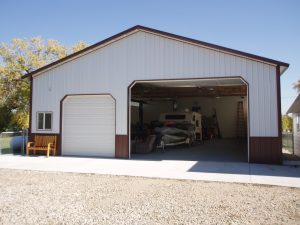Tim Carter is best known for his weekly syndicated “Ask The Builder” column. You can read more about Tim here: https://www.askthebuilder.com/tim-carter-autobiography/
Q. I can’t tell you how many thousands of dollars I’ve spent on remote storage facility fees. I want to put all my stuff on my own land in a dream garage. I realize a garage can be detached as well as attached to my home. Have you built the dream garage for yourself or a client? Would you please share with me what your dream garage would be like if you could wave a magic wand? I want to get it right this time and am so very tired of banging my car and truck doors against things when I have to squeeze to get in and out of my car. – Amanda G., Westport, Conn.
A. I’m not really a betting person (although I did bet my son years ago I could make a basket and lost), but I’m willing to wager a lot of readers have the same frustration Amanda does with her garage, which was probably built for gnomes or hobbits. My own garage – which I didn’t build – is too narrow. I see narrow garages all the time and for the life of me can’t understand how this mistake is perpetuated.
I’ve built several garages for myself, my daughter and clients that have gotten pretty close to the dream level. It’s not hard to do, but it does require a little more space than you might realize.
To solve any planning problem, you must start from the inside and work out toward the outer walls. You can do this with simple ¼-inch graph paper. A simple sheet that’s 8½ inches by 11 inches will accommodate your perfect garage. Each block can represent one foot in your plan.
I suggest we solve the garage width issue first. The biggest thing that goes in most garages is a car or truck. My neighbor once tried to get his powerboat and trailer in his garage at an angle and got frustrated in a hurry. He was fuming, but that’s a story for another day.
Cars are bigger than you think. My 1969 VW Beetle was more than 13 feet long. My current pickup truck is almost 21 feet long. My truck width with the side-view mirrors out is almost 9 feet. My car’s width is close to 7 feet 6 inches. Most car and truck doors swing out about 3 feet. Do you see where this is headed?

You’d be wise to incorporate 10-foot-wide garage doors that are 8 feet tall for starters. If you’re going to have two doors, make sure there’s 4 feet of space minimum between the two openings. This allows you to open the car doors and not bang them into the one in the other bay.
Let’s talk about the sidewalls of the garage. You already know you need 3 feet of space to open a door, but now you need to think about what’s stored on the wall. Garbage cans can be 30 or 36 inches deep or in diameter. Go into your existing garage and see how cramped it is between the side of your car and whatever is stored along the wall.
You’ll quickly come to the conclusion that you need at least 5 feet of space from the garage door opening to the inside surface of the sidewall. You may get by with 4 feet, but you’ll eventually shake your head at not going for the 5 feet. Add all these numbers up and you’ll discover that your garage foundation should probably be 36 feet wide.
The depth of your dream garage is simple. Once you do some math, you’ll see that it should be no less than 30 feet deep. This gives you lots of space for a workbench, bikes, garden tools, etc. A garage 34 or 36 feet deep approaches dream dimensions.
Here’s a list of other things that will make your garage one that friends and neighbors will salivate over. Install radiant floor heat. You can create the needed hot water with a simple water heater in almost all cases. Be sure the ceiling height is no less than 10 feet. This allows you to put in a small storage loft that hangs out over the hoods of your vehicles.
Consider a narrow 6-foot-wide overhead garage door for the rear wall to give you easy access for lawn equipment going in and out. Install floor drains under each vehicle and slope the concrete floor so snow melt runs into the drain and doesn’t pool against the garage doors. You’d be surprised how many building inspectors will permit these floor drains. Install on the house wall a hose hydrant with both hot and cold water so you can hose things off with warm water and wash your car indoors in the winter.
Don’t skimp on electric outlets, for goodness sake! Think about where you’ll have a workbench and provide for plenty of power there. Be sure to put an outlet on the wall in between the two front garage doors. This outlet will come in handy when you’re working on something in the driveway. Think about 240-volt outlets in case you like to weld or have other heavy-duty electric needs.
Insulate and drywall the interior surfaces of the garage when you build it, not later. If you wait until a later date, it may never get done and you will have to move everything out of the garage to accomplish the task.






